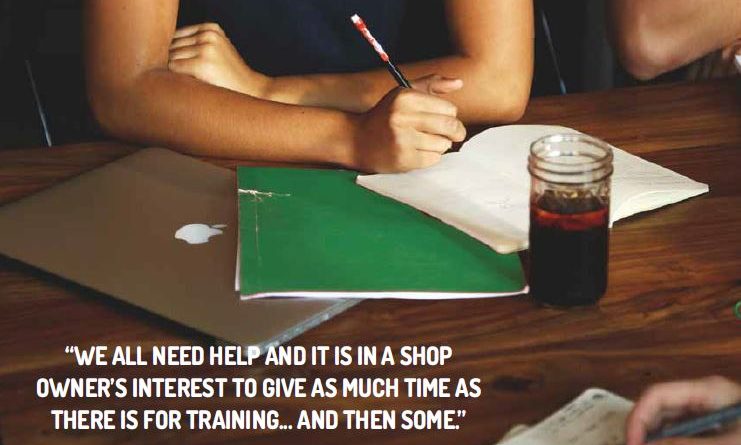Sales Trainer’s comment: Just don’t call it training
The label ‘sales training’ can be off-putting to shop staff, but adding a skills session to the end of a standard meeting can be a more palatable way to refresh staff skills. Sales training expert Colin Rees provides his tips on how to get the best out of sales personnel…
When I started writing this series of articles, we were losing stores like Woolworths and other iconic brands. Since then, high street decline has accelerated with some of the best-known brands in the frame.
But even with those changes to High Street shopping, it comes home to roost in the bike industry with the news, that Sports Direct is bailing out… would you believe… Evans.
Of all the stores we probably did not expect to see in trouble, Evans’ 60 branches seemed not to be one. The report I read mentioned the reason sales dipped being competition from the internet. I well recall meeting with them and saying that the principle of overstocking, to the point of not being able to get a bike out to show a customer to ensure a sale was made, seemed contrary to the amount of capital tied up in such a policy. Apparently, I was told, it was not an issue. They never seemed to believe in the results that can come from training; like doubling accessory sales for instance.
Happily, the hedge fund owners are only looking for £10 million although their loss last year was reported at £17.5 million but more to the point, when the mainstay of the retail cycling world dips, it comes home that unless smaller businesses do something about their operation right now, their future could be grim.
It was for that reason that these articles have attempted to convince owners to look carefully at their market and how they approach things, to become somewhere customers would just never replace, and hopefully, something has already changed. If you missed any articles in this series, they can be found on this website.
Always looking for areas where the internet cannot touch the high street, we have covered some of those and at the end, a summary will help with your planning. In the meantime, recalling the proper ethics of a good author, I continue with a promise made last time to cover more areas that can be put in the way of a customer considering an internet purchase as well as thinking about human nature. As usual, it is all about how you do it.
Have you ever tried sending an internet purchase back? What a hassle. Does an internet provider give a free first service? Maybe at least half the saving from buying on the ‘net could be justified and may not be too short of your price, when you take all the customers’ costs and risks into account. Does he have the tools to put it together? Will he do so safely? He thinks it will be like IKEA, but it’s different with bikes. Do it wrong and you could die.
The last area of human nature I want to look at, is where a sales person stands below a display of products pointing to each one he describes. Again, why take it down when it might not be right for the customer and I’ve only got to put it back? Put another way, I can’t be bothered. Yet the practice of putting products into customer’s hands every single time, regardless of what they
are, can increase sales by 5% mainly, because once holding it, it is very difficult to give it back if the sales person doesn’t stand too close. Human behaviour at work.
So human nature can kill many sales as customer’s expectations are not met. It can adversely affect the performance of a salesman and at the same time, it can be a huge help in making the sale. How perverse is that? Next time you are active with a customer, think back after they go how many times in that conversation human nature came into play. If you have never considered it before, you will be amazed. For those experienced in selling, it can become a fascinating area and if cultivated can be of great assistance, as you can plan successful strategies but be aware of the pitfalls. Top flight, professional sales people study it. Personal culture is powerful, the reason a professional adapts himself and his sales process to fit every individual.
Creating a store where people come back time and time again is one way to offset the negative impact of internet purchasing. Assuming the raw material is adequate, one of the steps that managers have to consider to reach that objective is staff sales training.
Training staff is something most owners I have met would rather leave to me. One of my objectives is persuading management, after I leave, to run sessions regularly to help staff become proficient but also to achieve the real objective of making this “the way we sell together” in that store, which is the ultimate goal.
Looking back at my career in the bike trade, I have carried a number of crosses that owners seem blind to. It is not that they do not understand, it seems more that they can’t see the point. One is discounts, we won’t go there again but giving my money away has always seemed weird to me as it is hard to make. The other, is persuading owners to train their staff and give them extra skills, preach teamwork and make them more efficient and profitable. I referred earlier to doubling accessory sales – some shops have trebled it after I go.
Some years ago, I advertised courses for management in how to train bike people. I never ran one, there was no demand. So I wrote a section into the management training course for bike shops and it was said to be one of the best, most useful sections.
Accepted, time is always short, managers are not trained in how to train, staff do not accept training as ‘acceptable’ unless there is an end result and you will recall from previous articles, my suggestion is for an open ended, team, profit-sharing programme to be the goal.
The way to institute something the team will not readily go for, is to call it something else. I well recall running a morning meeting and moving seamlessly from the day-today business of what we will achieve that day, into ‘let’s talk about closing the sale’. I never called it training, it was refreshment because staff forget techniques if they do not integrate them as “this is the way we sell together”.
If we are to create a store people want to come back to, one with the hard core we have been describing whose customers would not go anywhere else, we need trained staff who have been nurtured to follow a path to a ‘yes’. It takes regular training to create a team of people who ‘move’ from their present, ingrained attitude of ‘it doesn’t make any difference’ to a place where you know, from the minute you walk in the door, it is a different environment. Nothing is too much trouble. Everyone is happy. It is a hive of industry, there is so much going on. It is friendly, colourful, welcoming, the right temperature, a place, as a customer, I really want to be even if I only came in two days ago.
An example of staff attitude might be where, if one enters with a complaint and is very courteous but firm, one is made out to feel the complaint was your fault; told perhaps that it has never happened before, it isn’t their fault that’s for sure. Put that against someone who smiles, is apologetic that you had the trouble of coming back, is only too willing to put it right because indeed, there may not be anything wrong with it, but my expectation has not been met and it needs dealing with because I want you to come back.
That is the result of training. No staff member could ever make that change on their own. We all need help and it is in an owner’s interest to give as much as there is time for… and then some. Just watch the business thrive if you start regular discussions you do not call training.
Read more from Colin Rees:
How the marginal gains approach can add up to profitability
Anticipating customer behavious can give you a sales advantage.
Colin Rees
Retail Sales Trainer & Business Consultant.
w colinrees7.wordpress.com
e Colinrees7@gmail.com



